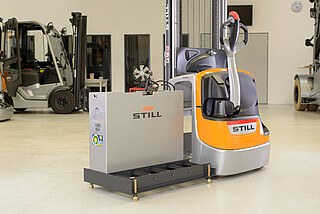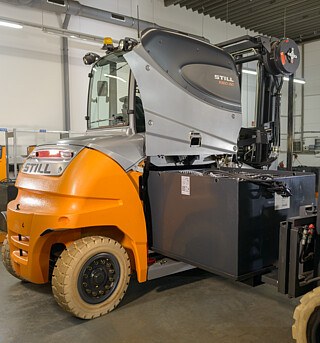Six tips to maximise your forklift truck battery life

Electric forklift trucks are a significant investment for any business, and the cost of the battery makes up a large portion of the spend. Maximising your forklift truck battery life not only helps you get the most out of your vehicle fleet in terms of performance and efficiency but can help you make the most of your investment.
Forklift truck batteries most commonly come in two varieties: lithium-ion and lead acid. Lithium-ion batteries have many benefits, including being virtually maintenance free, although they tend to be more costly than their lead acid counterparts which are commonly found in the warehouse. Lead acid batteries tend to have a shorter lifespan than lithium batteries, however there are plenty of opportunities to maximise their performance and total output.
Stick to a battery charging schedule
Lead Acid batteries typically take around six to eight hours to fully charge (whereas li-ion batteries take an hour or two) so a charging schedule can help you get the most out of both your vehicle fleet and your battery. You should never partially or “opportunity “charge a lead acid battery (more details on that below) and the best way to do this is plan in charge times where trucks can be taken off the warehouse floor and allowed to fully charge before going back to work. This is especially useful if you have a fleet of vehicles so you can have some trucks working while others are charging, and then swap them as required.
Don’t let the battery charge drop below 20%
A general rule of thumb is you should not let your forklift truck lead acid batteries discharge more than 80% of its power – meaning their total remaining charge shouldn’t fall below 20% remaining capacity. Letting the power level drop too low is known as “deep discharging” and can harm the battery itself, as well as causing electrical components to run hot which can cause further damage to the electrics system. Over time, this affects the life of the battery and will ultimately result in it needing to be replaced sooner.

Don’t partially charge a lead acid battery
Lead acid forklift truck batteries typically last 1,000-1,500 charging cycles before they need to be replaced. This means that if you charge the battery only halfway, you’re effectively going to be “using up” two of those cycles to charge the battery fully. This can essentially reduce capacity and half the life of your battery. If you ensure that your batteries are fully charged each time, you can reduce the total number of charges required and maximise the battery life.
Electric forklifts that use li-ion batteries can be fully charged much faster and benefit from so-called “opportunity charging” – shorter charging periods while the operators are on breaks or during shift swaps – as well as lasting twice as many charging cycles as a lead acid battery. This means that you need to plan your lead acid and li-ion battery charging schedules differently depending on the makeup of your fleet.
Check your water levels (Lead Acid Only)
Monitoring your forklift truck battery’s water level is an important part of regular maintenance and enables the battery to function at maximum efficiency and lifespan. It’s important to keep water levels balanced because too much water can damage a battery just as much as not enough water. If the water level falls too low, components within the battery are exposed to the air which causes them to dry out and become brittle. However, too much water in the battery can cause liquid to overflow as it expands during operation and the hazardous fluid can pose a health and safety risk to operators.
Clean your batteries every month
Like any industrial equipment, regular maintenance and checks can help prolong the life and maximum performance of your forklift battery. Build-up on the components, incorrect water levels, corroded charge points, all can have a negative impact on charging times and effective operation. Regular maintenance also allows you to spot potential defects before they result in sudden, unexpected failures that can take a vehicle out of operation without notice.
Keep your warehouse temperature optimal
It’s no secret that extreme temperatures affect the performance of lead acid rechargeable batteries, but people tend to think mostly about cold temperatures. While it is true that colder temperatures result in slower chemical reactions that can reduce performance, excessive heat can also cause damage to forklift truck batteries and reduce their lifespan. Regulating the temperature of your warehouse can help extend the life of your battery during storage, use and charging. If your forklifts are required to operate in extreme temperatures, it’s important to invest in a truck battery designed for those conditions.
Maximising the life of your forklift truck batteries can contribute to warehouse efficiencies and cost-savings in both the short and long term. If you’ve got any questions about electric forklift trucks, servicing agreements or utilising li-ion batteries, you can contact the STILL team for more information.
Comments
Subscribe to our blog!
As soon as a new article is published, we will notify you! You can unsubscribe at anytime.

Leave a comment